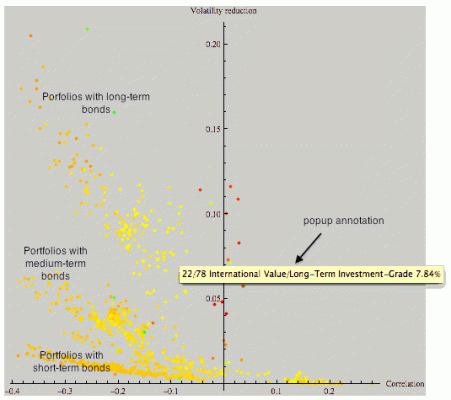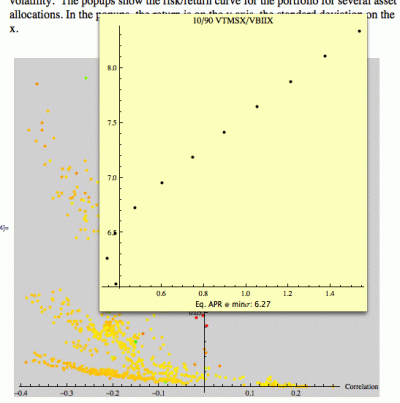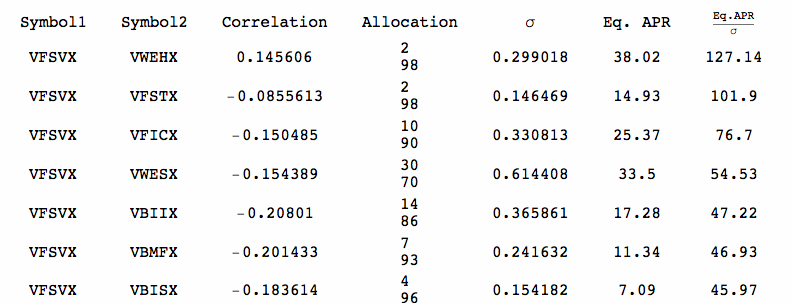IndependentlyPoor
Thinks s/he gets paid by the post
Warning: Long and Geeky
I have been interested in "modern portfolio theory" for some time. Basically, it is the something-for-nothing aspect of reducing a portfolio's volatility be combining funds with negative correlations that intrigues me.
While there is nothing wrong with combining a money market fund or a short term bond fund with a high volatility stock fund, you miss out on the something-for-nothing aspect. When you combine two such funds, the resulting portfolio will always have greater volatility than the money market fund, along with the greater return (usually). You are just making a risk/return trade off, depending on the relative allocation of the "risky" and "safe" funds. This is a result on the two funds having essentially zero correlation.
However, if you combine two funds that are negatively correlated, you can (theoretically) produce a portfolio that has less volatility than either fund.
To test this out, I wrote a script that found the optimum allocation of all possible two-fund portfolios of Vanguard stock and bond funds (not including money market funds, because I couldn't get data for them), 700 some-odd portfolios. I defined optimum as the allocation that produced the minimum volatility, as measured by the standard deviation of the percentage change in NAV.
Here are the results from the portfolio that enjoyed the greatest reduction in volatility, the FTSE All-World ex-US Small-Cap Index (VFSVX), and the Long-Term Treasury Fund (VUSTX).

The graph shows the the Equivalent APR vs. the standard deviation. The minimum volatility of about 0.6% daily change in NAV occurs at about a 30/70 allocation. Now VFSVX has been around for less than a year, and has a spectacular rise, so a portfolio of these two funds is not a candidate for a core holding, but it does show how the risk return of portfolios comprised of funds with high negative correlations look.
Notice that the minimum volatility point is less than that for either fund by itself. A portfolio of 100% VFSVX had a 60%+ return last year, but also more than 1% standard deviation in the daily NAV, Ouch. VUSTX also had a good year with about 6% return and 0.8% standard deviation, but the 30/70 mix more than doubled the yield of a 100% VUSTX portfolio, while reducing its volatility. That is the something-for-nothing aspect that interested me.
On the other hand, portfolios constructed of positively correlated tended to look like this graph of portfolios of the Emerging Markets Index Fund and the High-Yield Bond Fund:

The minimum volatility occurred at 0% VEIEX and increased almost linearly with increasing VEIEX allocation.
Unfortunately, more popular combinations, such as Total Stock (VTSMX) and Total Bond (VBMFX) don't show much benefit in volatility reduction, and the minimum occurs at about 10% VTSMX.

All of this is sort of interesting, but the effects are small. The best standard deviation reduction in percent daily NAV change was about 0.2%... not earth shattering. It seems like that while the claims made for "modern portfolio theory" are true, the effect is just too small to be very important. No free lunch after all.
I have been interested in "modern portfolio theory" for some time. Basically, it is the something-for-nothing aspect of reducing a portfolio's volatility be combining funds with negative correlations that intrigues me.
While there is nothing wrong with combining a money market fund or a short term bond fund with a high volatility stock fund, you miss out on the something-for-nothing aspect. When you combine two such funds, the resulting portfolio will always have greater volatility than the money market fund, along with the greater return (usually). You are just making a risk/return trade off, depending on the relative allocation of the "risky" and "safe" funds. This is a result on the two funds having essentially zero correlation.
However, if you combine two funds that are negatively correlated, you can (theoretically) produce a portfolio that has less volatility than either fund.
To test this out, I wrote a script that found the optimum allocation of all possible two-fund portfolios of Vanguard stock and bond funds (not including money market funds, because I couldn't get data for them), 700 some-odd portfolios. I defined optimum as the allocation that produced the minimum volatility, as measured by the standard deviation of the percentage change in NAV.
Here are the results from the portfolio that enjoyed the greatest reduction in volatility, the FTSE All-World ex-US Small-Cap Index (VFSVX), and the Long-Term Treasury Fund (VUSTX).

The graph shows the the Equivalent APR vs. the standard deviation. The minimum volatility of about 0.6% daily change in NAV occurs at about a 30/70 allocation. Now VFSVX has been around for less than a year, and has a spectacular rise, so a portfolio of these two funds is not a candidate for a core holding, but it does show how the risk return of portfolios comprised of funds with high negative correlations look.
Notice that the minimum volatility point is less than that for either fund by itself. A portfolio of 100% VFSVX had a 60%+ return last year, but also more than 1% standard deviation in the daily NAV, Ouch. VUSTX also had a good year with about 6% return and 0.8% standard deviation, but the 30/70 mix more than doubled the yield of a 100% VUSTX portfolio, while reducing its volatility. That is the something-for-nothing aspect that interested me.
On the other hand, portfolios constructed of positively correlated tended to look like this graph of portfolios of the Emerging Markets Index Fund and the High-Yield Bond Fund:

The minimum volatility occurred at 0% VEIEX and increased almost linearly with increasing VEIEX allocation.
Unfortunately, more popular combinations, such as Total Stock (VTSMX) and Total Bond (VBMFX) don't show much benefit in volatility reduction, and the minimum occurs at about 10% VTSMX.

All of this is sort of interesting, but the effects are small. The best standard deviation reduction in percent daily NAV change was about 0.2%... not earth shattering. It seems like that while the claims made for "modern portfolio theory" are true, the effect is just too small to be very important. No free lunch after all.





